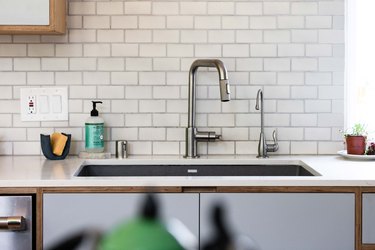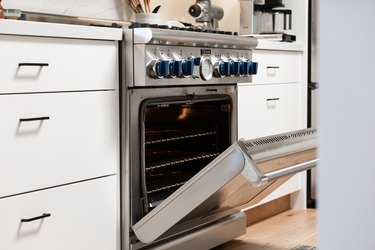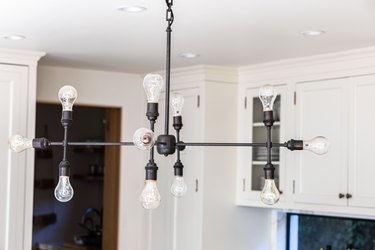In This Article
The modern kitchen is a masterwork of electrical convenience, thanks primarily to the National Electrical Code (NEC). The NEC is the guidebook that outlines all of the kitchen electrical circuits you need for a remodel or new home build, and it's based on how we use our kitchens every day. Following the NEC recommendations, your new or renewed kitchen will almost certainly include at least six electrical circuits, but most kitchens have even more.
The driving idea behind the NEC guidelines is making sure you have enough power for all of your appliances as well as enough places to plug them in. For example, the outlets above the countertop areas are supplied by two of their own circuits, and no place on the counter is more than 2 feet from an outlet. An updated kitchen may also have electrical circuits for the range, refrigerator, dishwasher, garbage disposer, microwave and, of course, the lights.
Video of the Day
Video of the Day

Electrical Circuit Basics
In simple terms, an electrical circuit is a loop of wiring. It starts at the breaker in the home's breaker box, or service panel. From there, electrical cable (containing multiple wires) winds through the walls or floors and connects to various devices (outlets, switches, light fixtures, appliances, etc.) on the same circuit. When a circuit supplies only one appliance or specific devices, it is called a dedicated circuit. Dedicated circuits ensure there is sufficient power for the demand of the circuit's load. In other words, they keep the lights from dimming when you turn on your toaster oven.
Electrical circuit rules dictate not only for what a circuit is used but also the voltage and amperage rating of the circuit wiring and devices. Most household circuits are rated for 120 volts and either 15 or 20 amps. Circuits for large appliances often supply 240 volts and anywhere from 30 to 60 amps. In case you're curious, volts and amps combine (multiply, actually) to produce wattage or watts, a term everyone knows from light bulbs. Wattage is the unit of power used to determine the electrical capacity of a circuit as well as the electricity usage of an appliance.
Due to all of the water and wetness present in a kitchen, several kitchen electrical circuits must have GFCI (ground-fault circuit-interrupter) protection to minimize shock hazards. For example, all countertop outlets and any outlet within 6 feet of a sink must be GFCI-protected. This includes outlets installed inside a cabinet for supplying a garbage disposer or dishwasher.
In addition, all 120-volt, 15- and 20-amp circuits must have AFCI (arc-fault circuit-interrupter) protection to protect the circuit wiring against fire hazards. There are multiple methods for providing AFCI and GFCI protection, but the simplest solution is to use dual-function AFCI/GFCI circuit breakers.
Small-Appliance Circuits
Following NEC guidelines, every kitchen must have at least two so-called "small-appliance" circuits. These are 120-volt, 20-amp circuits and are primarily dedicated to the countertop outlets. They should also include all exposed outlets in the kitchen, pantry and any dining area adjacent to the kitchen.
The refrigerator may plug into an outlet on a small-appliance circuit, or it can have its own circuit. Lighting and hard-wired appliances may not be connected to these circuits, although you can use them to power a clock (by itself, not as part of an appliance) or the ignition device on a gas range, oven or other type of gas cooking unit.
Most kitchens don't need more than the required two small-appliance circuits, but very large kitchens may benefit from more than two. An electrician can help determine how many outlets you should have on each circuit.
Circuits for Refrigerators
A dedicated circuit for a fridge-freezer is one of the optional kitchen electrical circuits. In most cases, the electrician or local building department will make the call (the building department enforces all of the electrical code rules for your kitchen). If you have a large fridge in a large kitchen, you might want the assurance of a dedicated 15- or 20-amp, 120-volt dedicated circuit for the fridge. Otherwise, it's fine to plug the fridge into one of the small-appliance outlets.
One thing to watch out for is GFCI protection. If the fridge plugs into one of the small-appliance outlets and that circuit has a GFCI breaker, the fridge will be subject to GFCI tripping. This means that if your toaster has a short and trips the GFCI breaker, your fridge will be out of power. However, if the fridge outlet is within 6 feet of a sink, it needs GFCI protection in any case.

Dishwasher and Garbage Disposer Circuits
Dishwashers and garbage disposers may or may not be allowed on the same circuit; it's up to the local code authority. The NEC says it is permissible to have one circuit supplying both the dishwasher and a disposer if the combined wattage ratings of the appliances do not exceed the circuit capacity. However, many local codes require a dedicated 15- or 20-amp, 120-volt circuit for each appliance. Both dishwashers and garbage disposers can be hard-wired or plugged into an outlet.
If the garbage disposer plugs into an outlet under the sink, the outlet is often installed with a "split-wire" configuration. This allows one half of the outlet — the half where the disposer plugs in — to be controlled by a wall switch while the other half is always live (not switch-controlled), as with a regular outlet.

Range, Oven and Cooktop Circuits
Electric ranges, ovens and cooktops use a lot of power and always require a dedicated circuit. The standard for a range is a 240-volt, 50-amp circuit. Circuits feeding a built-in oven or a cooktop are also 240 volt but may have a lower amp rating, such as 30 or 40 amps. Technically, these circuits provide both 120 and 240 volts — 120 volts for the timers, lights, clock, etc. and 240 volts for the heating elements. Freestanding ranges typically plug into a special 4-prong outlet so that they can be removed. Ovens and cooktops usually are built-in appliances and are hard-wired. Gas ranges and cooktops use much less power than electric models and usually connect to standard 120-volt circuits.
Kitchen Circuits for Microwaves
Microwave ovens are either portable appliances (always connected with a cord and plug) or permanently installed (connected with a cord and plug or a hard-wired connection). A corded microwave can plug into one of the small-appliance circuit outlets, or it can have its own 20-amp, 120-volt outlet on a dedicated circuit. Hard-wired microwaves should be connected to a dedicated 20-amp circuit.
One argument for adding a dedicated circuit even for a plug-in microwave is that these appliances draw a lot of power if only for a short period. A standard-size microwave is rated for 1,000 watts, and many large units are rated for 1,200 or more watts. The heavy draw from a large microwave running on high can easily (if temporarily) put a damper on the rest of the circuit. If you try to run a toaster oven and a mixer on the same circuit as a microwave, you might overload the circuit and trip the breaker.
Kitchen Lighting Circuits
NEC rules for kitchen lighting are relatively flexible. You're required to have at least a source of general lighting controlled by a wall switch, and the fixtures and switch can be supplied by any standard lighting circuit in the house. The same circuit can supply lighting in the dining room or a nearby living space, for example. Of course, most kitchens are fully loaded with lights — on the ceiling, under the cabinets, hanging above an island, etc. The only limitation here is the circuit capacity. Lighting circuits are 120 volts and 15 amps. With today's energy-efficient light bulbs (why use anything else?), it's usually possible to supply all of the kitchen's lights on a single circuit, even in large kitchens.
The trick to lighting circuits in the kitchen is having the right number of switches. You can have one switch control most or all of the lights, or you can have separate switches for different types of lighting. For example, you might want to have island pendants or above-cabinet accent lighting on their own switch so you can flip them on for ambiance without turning on the bright overhead lighting.
Circuits for Kitchen Ventilation
Kitchen ventilation equipment or appliances come in a range of types and use different sources of power. A built-in vent on a microwave is simply part of the appliance and is powered accordingly — either hard-wired on a dedicated circuit or plugged into a small-appliance circuit or a dedicated outlet.
A vent hood is a separate appliance and is usually hard-wired to one of the kitchen's lighting circuits. However, large vent hoods that draw a lot of power may need their own circuit lest the lights dim when you fire up the vent fan. Most vent fans do not need more than a 15-amp dedicated circuit — the same amperage you have on standard lighting circuits.
